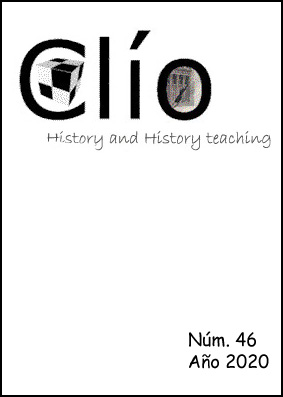Auschwitz Photographic Project: The Horror Scene
DOI:
https://doi.org/10.26754/ojs_clio/clio.2020465299Keywords:
informal education, Photography, Holocaust, informal learningAbstract
The educational project Auschwitz: The Horror Scene takes place between 2017 and 2019, from its gestation to the photo exhibitions and talks-colloquium in which it has been framed. It is part of an informal teaching, in which learning is determined by everyday situations of social contact, which is not organized or managed by a specific educational strategy. It is an experience that takes place in relaxed settings, as in the case of cultural associations or city councils. The author of the photographs plays the symbol of the visitor's gaze, who, through his camera, shows us the Auschwitz death camp, describing the feelings and sensations that could occur there in the early years of the decade of the 40.
Downloads
References
Arendt, H. (2003). Eichmann en Jerusalén. Un estudio sobre la banalidad del mal. Lumen.
Asensio, M. (1994). Los autómatas de Hefesto o el procedimiento para crear seres procedimentales. Íber. Didáctica de las Ciencias Sociales, Geografía e Historia, 2, 79-98.
Asensio, M. y Pol, E. (1999). Nuevos escenarios para la interpretación del Patrimonio: el desarrollo de programas públicos. En C. Domínguez, J. Estepa y J. M. Cuenca (Eds.), El Museo: Un espacio para el aprendizaje. (pp. 47-77). Universidad de Huelva.
Asensio, M. y Pol, E. (2001). Nuevos escenarios en educación. Aprendizaje informal sobre el patrimonio, los museos y la ciudad. Aique
Asensio, M. y Pol, E. (2008). Conversaciones sobre aprendizaje informal en museos y patrimonio. En H. Fernández (Ed.), Turismo, Patrimonio y Educación. Los museos como laboratorios de conocimientos y emociones (pp. 19-60). Escuela de Turismo de Lanzarote.
Bauman, Z. (2007). Tempos líquidos. Editora Schwarcz–Companhia das Letras.
Bordieu, P. (2003). Un arte medio. Ensayo sobre los usos sociales de la fotografía. Gustavo Gili.
Clus, M. Le (2011). Informal learning in the workplace: A review of the literature. Australian Journal of Adult Learning, 51(2), 355-373.
Csikszentmihalyi, M. (1975). Beyond boredom and anxiety. Jossey- Bass.
Csikszentmihalyi, M., Abuhamdeh, S. y Nakamura, J. (2005). Flow. En A. J. Elliot y C. S. Dweck (Eds.), Handbook of competence and motivation (pp. 598-608). Guilford Publications.
Cole, Michael (1999). Psicología cultural. Morata.
Deci, E. L. y Moller, A. C. (2005). The concept of competente. En A. J. Elliot y C. S. (Eds.), Handbook of competence and motivation (pp. 579-597). Guilford Publications.
Deci, E. L. y Ryan, M.R. (1991). A motivational approach to self: Integration in personality. En R. Dienstbier (Ed.), Nebraska symposium of motivation. Perspectives on motivation, 38, 237-38.
Deci, E. L. y Ryan, R. M. (1985). Intrinsic motivation and self-determination in human behavior. Plenum Press.
Dussel, I. y Gutiérrez, D. (2006). Educar la Mirada: Políticas y pedagogías de la imagen. Manantial.
Engeström, Y., Miettinen, R. y Punamäki, R.-L. (1999). Perspectives on activity theory. Cambridge University Press.
Galperin, P. Y. (1992). Stage-by-stage formation as a method of psychological investigation. Journal of Russian and Eastern European Psychology, 30, 60-80.
Hager, P. y Halliday, J. (2009). Recovering informal learning: Wisdom, judgement and community (Vol. 7). Springer Science & Business Media.
Hiemstra, R. (1981). The implications of lifelong learning. Museums, Adults and the Humanities, AAM, 120-130.
Knowles, M. S. (1981). The future of lifelong learning. Museums, Adults and the Humanities. AAM.
Leont'ev, Aleksei N. (1972). The problem of activity in psychology. En J. V. Wertsch (Ed.), The concept of activity in Soviet psychology (pp. 37-71). Sharpe.
Luria, A. R. (1979). Conciencia y lenguaje, Visor, 1984, 2ª ed.
Marsick, V. J. y Watkins, K. (1990). Informal and Incidental Learning in the Workplace. Routledge.
Maclean, R. y Wilson, D. (Eds.) (2009). International handbook of education for the changing world of work: Bridging academic and vocational learning. Springer Science & Business Media, 1.
Mortimer, E. y Shonick, K. (2010). El Holocausto y la colección de documentos de debate de las Naciones Unidas. https://www.un.org/es/holocaustremembrance/docs/paper11.shtml
Opitz, H. A. (2007). Didáctica Fotográfica. Revista: Experiencias y propuestas en la Construcción del Estilo Pedagógico en Diseño y Comunicación, 7, 236-239.
Rodriguez-Illera, J. L. y Kaechele, M. (2009). Digital Literacy and Activity Systems in Adolescents. En Comparative Information Technology (pp. 89-102). Springer.
Sontag, S. (1996). Sobre la fotografía. Edhasa.
Schugurensky, D. (2006) This is our school of citizenship. En Z. Bekerman, N. C. Burbules, y D. S. Keller (Eds.), Learning in places - the informal education reader. Peter Lang.
Screven, C. G. (1974). The Measurement and Facilitation of learning in the Museum Environment: An Experimental Analysis. Smithsonian Institution Press.
Tedesco, J. C. (2005). La Educación Popular Hoy: Claves para todos. CI - Capital Intelectual.
UNESCO ONU (2005). Resolución 60/7. https://www.un.org/en/holocaustremembrance/ docs/res607.shtml
VV.AA. (2013). Global Perspectives on Holocaust Edication. Trends, Patterns and Practices. United States Holocaust Memorial and Salzburg Global Seminar. https://holocaust.salzburgglobal.org/fileadmin/ushm/documents/Overview/May2013 _GlobalPerspectives_final.pdf
Vygotsky, L. (1978). Pensamiento y lenguaje. Paidós.
Downloads
Published
How to Cite
Issue
Section
License
Copyright (c) 2020 Inmaculada Sánchez-Macías

This work is licensed under a Creative Commons Attribution-NonCommercial-ShareAlike 4.0 International License.
This work is licensed under a Creative Commons Attribution-NonCommercial-ShareAlike 4.0 International License.
Copyright remains the property of authors. Permission to reprint must be obtained from the authors and the contents of JoS cannot be copied for commercial purposes. JoS does, however, reserve the right to future reproduction of articles in hard copy, portable document format (.pdf), or HTML editions of JoS.






